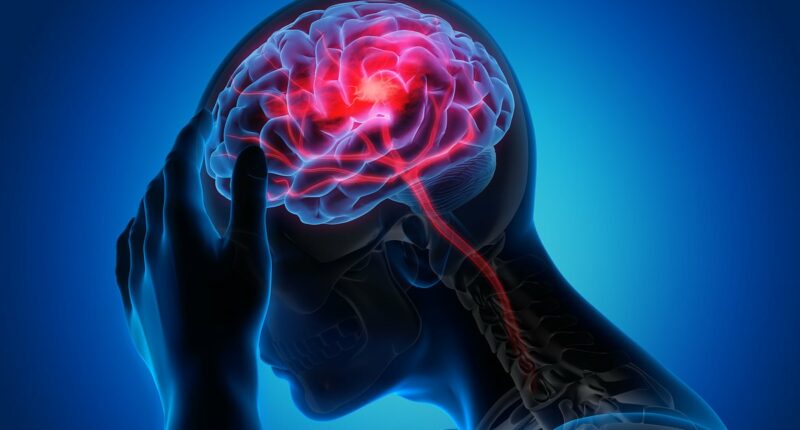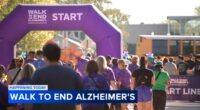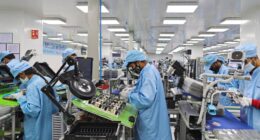Share this @internewscast.com
Throughout his career, Dr. Sean Dukelow has often found himself seated at the back of numerous lecture halls. Yet, few talks have captured his attention quite like one he attended nine years ago at the Quebec City Convention Center.
On an overcast fall morning, during the opening day of the 2016 Canadian Stroke Congress, scholars from various regions of the country and beyond assembled to hear Dr. S Thomas Carmichael discuss his findings on brain recovery.
For years, patients who experienced what is essentially a brain attack were given the disheartening prognosis that damage from oxygen deprivation meant irreversible loss, offering limited hope for substantial recovery.
Dukelow’s excitement grew as Carmichael, a neurologist from UCLA, explained how an older HIV medication might enable damaged brain cells to regenerate their connections.
‘A lightbulb went off,’ Dukelow told the Daily Mail.
He shared, “Listening to Tom Carmichael discuss these studies, where the animals showed significant improvement, felt incredible. Recognizing that he utilized a drug already on the market is game-changing, as it bypasses the lengthy process of developing a new drug from scratch, having already passed regulatory safety checks.”

Strokes occur when the brain’s blood supply is disrupted, resulting in swelling and tissue death. Without timely intervention, it can cause death and significant disability.

Dr Sean Dukelow, of Foothills Medical Centre in Calgary, spoke to the Daily Mail about leading the first major clinical trial of the drug Maraviroc in stroke and brain injury survivors
The drug was Maraviroc, first approved in 2007 to impede HIV from slipping into healthy cells. Carmichael and his colleagues had found that the same pill could also remove a natural hindrance to recovery after brain trauma.
Now, years later, Dukelow is leading the first major clinical trial of Maraviroc in stroke and brain injury survivors, hoping to prove that a medicine once used to fight a virus can also help this cranial organ repair itself.
The work is personal. As a young man, he watched his maternal grandfather suffer a stroke.
With no clot-busting drug such as tPA available at the time, the family doctor could do little more than prescribe aspirin and bed rest, and just wait to see if his condition improved.
‘“If it doesn’t, we’re in trouble,”’ Dukelow remembered the doctor saying.
His grandfather was confined to the basement of the family home, unable to climb the stairs to the living quarters.
‘I realized how crazy disabling a stroke could be,’ Dukelow said.
Not long afterward, his other grandfather had a transient ischemic stroke – often called a ‘mini stroke’ – followed by a fatal ischemic stroke a year later.
‘I think that had a pretty significant impact on where I was going in life,’ he said, speaking of his journey to become a stroke neuroscientist.
For most of the last century, medical students such as Carmichael and Dukelow were taught that the brain was a static organ. The Spanish neuroscientist Santiago Ramon y Cajal had declared in 1928 that, in adults, ‘everything may die, nothing may be regenerated.’
But by the 1990s, hints of recovery were appearing. ‘In 1996, I started my PhD,’ Dukelow said. ‘A graduate student showed me these slides of neurons re-growing themselves after they’ve been severed in a spinal cord.

Dr S. Thomas Carmichael, the head of neurology at the Geffen School of Medicine at the University of California, Los Angeles, discovered that the HIV drug Maraviroc, which blocks the CCR5 receptor, could dramatically enhance recovery after a stroke or brain injury

A CDC report found strokes have increased in people ages 18-64 by around 15 percent when comparing cases from 2011 to 2013 and those from 2020 to 2022
‘That was the first time I think I had realized that the brain and the spinal cord were not immutable – that things were changing.’
Carmichael was a resident at Washington University School of Medicine a few years earlier when he set out to understand what was happening.
His experiments showed that surviving neurons sprouted new connections after injury in an attempt to replace what had been lost.
‘I was doing a research rotation and wanted to apply the tools that I learned in my PhD to brain plasticity in the adult after stroke,’ Carmichael told the Daily Mail. These tools included directly measuring brain connections, quantifying them.
‘I did this in a rodent model of stroke and determined that the brain near the stroke formed new connections. Prior to this work, most of the field was simply staining brain sections for markers of neurons that are more plastic or more flexible,’ he said.
The evidence challenged decades of dogma.
Years later, as the head of neurology at the University of California, Los Angeles’ Geffen School of Medicine, Carmichael had been researching brain regeneration and the effect of strokes when a key turning point came.
A colleague, memory researcher Dr Alcino Silva, had found that a receptor called CCR5 was unexpectedly involved in learning and plasticity.
Silva discovered that blocking or reducing the protein on the surface of white blood cells actually improved memory.
Carmichael’s subsequent research showed that the brain ramped up production of CCR5 after a stroke. Instead of helping, it acted like a brake, shutting down the growth of new connections just as a recovery was beginning.
If that brake could be lifted, he thought, recovery might continue far longer.
By chance, the CCR5 protein was already well known in another field: HIV. The virus uses it as a doorway into cells. Maraviroc was developed to block that entry, protecting the immune system.
In a February 2019 paper in Cell, Carmichael explained how the drug also supercharged the rehabilitation process in mice. Animals treated with Maraviroc lost fewer dendritic spines (the tiny structures that carry messages between neurons) and grew more new axonal projections (the fibres connecting motor regions of the brain).
For Dukelow, watching the presentation outlining Carmichael’s research in Quebec more than two years earlier, reading this paper was the moment science turned into possibility.
‘Here’s something that’s a game changer,’ he recalled thinking at the time. ‘It could really turn up the volume on these patients who need a little extra boost to get across the finish line.’
At first, Dukelow didn’t approach Carmichael. The Maraviroc results were more proof-of-concept than hard fact, and his own experience in establishing and running clinical trials was focused on robotics and brain stimulation. It wasn’t a good fit.
But when he helped build CanStroke, a nationwide Canadian clinical trials network, the collaboration became organic as the pieces clicked into place.
‘I got approached by one of the neurologists at UCLA who said, “Hey, we think your network could run this trial.” And so, at that moment, I rallied the whole Canadian group in CanStroke and said, “We think we can do this. Does everyone agree?”’
Today, his team has recruited 46 patients of a planned 120. The trial is double-blinded – the gold-standard for clinical research in which neither doctors nor participants know who is receiving the drug or placebo – and will continue for two more years.
Dukelow is optimistic that they will be able to record the CCR5-blocking benefits of Maraviroc at the end to give stroke victims access to a potentially life-changing treatment.
He talks about an observational study called the Tel Aviv Brain Acute Stroke Cohort (Tabasco) in Israel that identified 68 stroke survivors with at least one copy of a natural mutation that cripples the CCR5 receptor.
‘After a stroke or brain injury, they walked better, their balance was better. Ultimately, their mobility was substantially better if they didn’t have the CCR5 receptor,’ Dukelow said.
‘And that hypothesis that is there – that not having the CCR5 receptor, or blocking it with Maraviroc, leads to increasing your ability to learn so that you can learn better, learn faster.’

The colors on the heatmap from Carmichael’s study represent the intensity of the inflammation in mice brains following damage, where red/orange mean a lot of inflammation and blue/green means less inflammation

Stroke symptoms are commonly remembered by the four-letter acronym, FAST. A patient’s face may drop on one side, they may struggle to lift both arms and have slurred speech. Immediate treatment for a transient ischemic attack (TIA) or minor stroke is essential as it can substantially slash the risk of a much deadlier major stroke
One participant in the Canadian trial, Debra McVean, 62, has shown marked improvement since a massive stroke in March 2024 left her paralyzed along the left side, according to The New York Times.
Though McVean remains largely reliant on a wheelchair a year into the trial, she reports signs that her brain is rewiring itself.
She can now make coffee and lift a one-pound weight in her left hand, feats that would have been impossible mere months ago, because her ‘fingers don’t feel like they don’t belong to me anymore.’
McVean can also wheel herself across her home and walk carefully upstairs wearing a brace, but will not know until the study ends whether she was given the Maraviroc or a placebo.
Her case illustrates what is at stake: Nearly 800,000 Americans experience strokes every year and hundreds of thousands more sustain traumatic brain injuries from accidents or violence.
But Maraviroc is by no means a potential miracle cure. Carmichael acknowledged that it has limitations, specifically its poor ability to cross the blood-brain barrier.
His primary focus, in any case, is not to promote a single drug, but to use Maraviroc as a tool to understand the brain’s recovery mechanisms and develop more effective future options.
Carmichael’s lab has since identified another drug that enhances motor regrowth in mice but such discoveries take years of painstaking research to go from promising ‘neurorehabilitation pill’ to FDA-approved treatments. Still, the potential is extraordinary.
But until Dukelow’s trial finishes, patients and doctors alike will be left waiting to see whether the lightbulb moment in that glistening glass convention center nearly a decade ago can truly illuminate a new path to healing.












